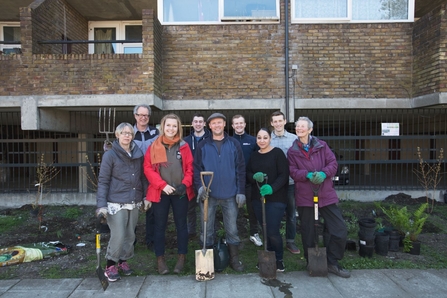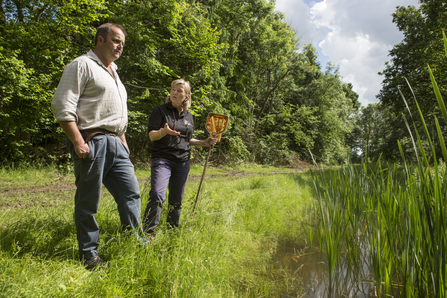Natural Flood Management
London - Habitat Restoration
London Wildlife Trust is working to restore Huckerby's Meadows, which lies east of Heathrow Airport. The meadows are being restored to improve their water management capabilities and enhance the site for wildlife. A win-win for local communities! About 30% of the site used to have hard ground surfacing; about 20% of the site has now been restored to grassland. Old meanders of the River Crane have been reconnected. The increased volume of the river coupled with the creation of high and low flow channels has increased the river's ability to store storm water, whilst still achieving great benefits for aquatic wildlife. The 10% of hard ground surface that remains at the site is an old car park and London Wildlife Trust is aiming to remove this, restoring it to soft landscaping.
London Wildlife Trust also has an urban flood-management project called Lost Effra - named after a river that flows through south London. This is working with local communities on a water management strategy for Herne Hill in south London, an area which is prone to flooding.
London Wildlife Trust published 'London: Garden City?', a report which revealed the scale of the capital's garden loss - at the time of publication in 2011. This was at a rate of two and a half Hyde Parks per year. Hard surfacing – including decking and paving – increased by over 25 per cent in the 100 month study period.
Town gardens can do much to act as sponges and help stop water flowing too fast and prevent rivers being overwhelmed and causing flooding.
Cambridgeshire - Habitat Restoration
The Great Fen is a 50-year project to create a huge wetland area in Cambridgeshire run by The Wildlife Trust for Bedfordshire, Cambridgeshire and Northamptonshire. One of the largest restoration projects of its type in Europe, the landscape of the fens between Peterborough and Huntingdon is being transformed for the benefit both of wildlife and of people. The land started to be drained for farming in the 17th century and more than 99% of this habitat with many rare species of plants and animals disappeared. Two of the last fragments of wild fen, Woodwalton Fen and Holme Fen, became National Nature Reserves, but even they are too small and isolated to support the special wildlife of the original fens. The plan is to create a landscape of 3,700 hectares around the existing National Nature Reserves. It will incorporate areas where winter flood waters can be stored after heavy rainfall, helping to protect surrounding towns, villages and farmland from the risk of flooding.
Water Quality
Devon - Working Wetlands
As part of Devon Wildlife Trust’s Working Wetlands project, advisers are working with landowners to address potential sources of pollution on farms with the aim of protecting water quality and restoring important wildlife habitats. Restored species-rich wet grasslands, often marginal to a working farm, act as natural filters to capture soil particles and nutrients from fertilisers before they reach rivers and reservoirs, thereby acting as effective buffers between agricultural practice and the water course.
An additional benefit of this kind of restoration is an increase in the capacity of the habitat to store water, thus relieving downstream flooding risk as well as reducing soil erosion and diffuse pollution.
So restoring our species-rich wet grasslands will, in turn, improve the water quality in our rivers.
Shropshire - Love Your River, Telford
There are eight waterbodies in Telford, all failing to meet water quality standards. Love Your River Telford, in which Shropshire Wildlife Trust is a partner, has trained and inspired the local community to spot and report water pollution. School children have become River Rangers, passionate and protective about their local rivers, and adults can volunteer for the Love Your River group, using their new training to monitor the health of their own patch.
Habitat restoration and creation is transforming the polluted waterways, using nature to improve water quality and flood management, producing new wetlands and wet woodlands. Six of the eight waterbodies have already improved and the project has plenty more to give. Snaking through an old brickworks, The Serpentine stream is a lifeless ooze of clay-clogged orange, but Love Your River Telford plans to bring it back to life by restoring its ailing reedbed.

© Fran Southgate
Catchment-based approach
Essex - Essex Rivers Hub Catchment Partnership
The Essex Rivers Hub is a partnership initiative led by Essex Wildlife Trust, Essex Biodiversity Project and the Environment Agency. This is an umbrella programme which includes several individual projects. One is the Essex River Wardens Project which is made up of more than 120 volunteers across Essex. These volunteers monitor a local section of river and work with project partners to raise awareness of the important projects and issues that we have in the catchment. Another is the Yellow Fish Campaign, which has also been used to engage schools in some areas of Essex, with further funding being sourced in collaboration with Ground Works to concentrate efforts in the Chelmsford Area.
Staffordshire - Restoring the River Trent in Staffordshire
A number of partnerships are working in the Tame and Mease Catchment to improve the river Trent for wildlife and for the people of Tamworth, Burton-upon-Trent and Lichfield. Staffordshire Wildlife Trust created small islands in the Trent using an innovative technique of partially burying live willow trees. Re-naturalising the river improves water quality and creates better conditions for fish, water plants and other aquatic species to thrive, which in turn benefits other wildlife. Restoring highly modified parts of the river and re-connecting it with its floodplain is improving biodiversity and making the river accessible for a wide range of people for recreation, including walking and canoeing. The river is now visible and safe to approach, when before it was hidden from view.
Cornwall and Devon - South West Catchment Partnerships
South West Water say that treating ‘clean’ raw surface water costs 20% less than treating water with a heavy sediment load. Its multi award-winning Upstream Thinking project is targeted at improving water quality at source. This is achieved through working with farmers and other landscape managers to reduce nutrient, sediment, pesticide and organic carbon inputs into stream waters. South West Water have set up an evidence monitoring programme to measure the economic benefits of the work.

Water vole © Amy Lewis
Farm advice
Shropshire
Shropshire Wildlife Trust is working with a farmer in the north of the county whose land was subject to extensive surface water flooding and run off, with this ultimately running into a tributary of the River Perry. The scheme is still under construction but a basin has been created where the water and silt can be captured, holding back flows. This work has already reduced the incidence of surface water flooding on the access track to the farm and fields further up the sub-catchment. The excavation of a long swale - a low area of marshy land - allows free drainage of previously blocked field drains. The new basin and swales and buffer strips around them will be seeded with wildflower and grass mixes in the spring.
Staffordshire
A similar scheme implemented by Staffordshire Wildlife Trust saved farmland from flood damage by making small-scale changes to land management and creating new wetlands.
Sussex
Sussex Wildlife Trust help to run the Sussex Flow Initiative, a Natural Flood Management (NFM) partnership project with the Woodland Trust and the Environment Agency. The project helps to reduce localised flooding and to increase water resilience across the County and particularly in the River Ouse and Powdermill catchments. This work includes strategic woodland creation, hedgerow planting, natural woody dams, pond and washland creation and other small scale natural flood enhancements. The Wildlife Trust work with local landowners and communities to help deliver NFM, subsidising natural flood interventions that help to store more water in the landscape.
Natural Flood Management has multiple benefits for people and wildlife including carbon storage, water purification, pollination, enhanced greenspace, more spaces for wildlife and flood mitigation.


